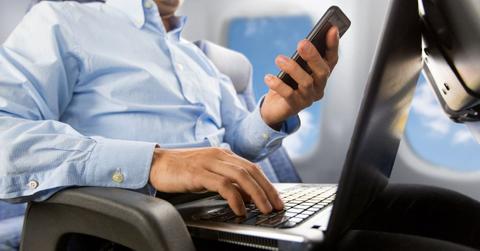Crash Course: Is Turning on 'Airplane Mode' During Flights Courtesy or Necessity?

While 'airplane mode' has persisted as a requirement for cell phone use to prevent signal interruptions on flights, it has largely served a different purpose for decades.
In the era of signal-transmitting devices being carried by airline passengers, the ritual of switching to "airplane mode" before takeoff has become ingrained. But is it truly essential?
While the mandate for airplane mode persists as a legal requirement aimed at averting navigation disruptions, its primary function over the years seems to have shifted.
Contrary to the long-standing belief that mobile signals could interfere with aircraft navigation systems, this notion has largely been debunked, as reported by Gizmodo recently.
Instead, the requirement in the United States to switch to airplane mode appears to be more about maintaining a harmonious onboard environment among passengers rather than a safety imperative.
The European Union took a significant step in 2022 by permitting phone calls and data usage during flights, coupled with the installation of "pico-cells" on planes. These devices manage phone signals to prevent interference with aircraft communication systems, a technology available for over two decades.
In a 2012 study, the Federal Aviation Administration (FAA) found no confirmed instances of cell phones affecting flight safety on aircraft equipped with pico-cells. Even without such devices, the FAA found scant evidence indicating cell phones interfere with flight systems.
The New Zealand Civil Aviation Authority, according to the FAA's study, reported only two potential instances of cell phone interference on planes lacking pico-cells, which weren't conclusively attributed to such interference.
Nevertheless, the FAA maintains its ban on cell phone use during flights, citing concerns that they "could interfere with critical aircraft instruments." Devices must be used in airplane mode or with the cellular connection disabled, according to the agency's website.
- What Lies Beneath: NASA Scientist Believes Aliens May Have Found 'Perfect' Hiding Spot in Earth's Oceans
- Global Threat: Russia Insider Warns West of 'World War Using Nuclear Weapons' Amid Escalating Support for Ukraine
- Countdown to Disaster? Ex-NATO Official Warns Russia, Iran and China Could Wage WWIII in Just Years
However, Gizmodo suggests that the prevailing reason for the persistence of airplane mode requirements is to mitigate "air rage" incidents stemming from excessive phone usage during flights, a problem that has surged in recent years.
Between 2021 and 2023, the FAA reported a staggering 300 percent increase in unruly passengers, totaling over 10,000 cases.
Never miss a story — sign up for the Front Page Detectives newsletter. Be on the scene the moment news breaks.
The agency's 2012 report highlighted instances where flight attendants encountered noncompliant passengers regarding cell phone use, leading to removals from aircraft and in some cases, in-flight diversions.
While some airlines noted complaints about loud conversations from cell phone users, overall, negative passenger feedback on onboard cell phone use was limited, according to the FAA.
Despite considerations to revisit regulations in 2013, concerns about disturbances to onboard tranquility prompted the retention of the rule. Consequently, although cell phones may not pose a risk to navigation, failure to switch to airplane mode can result in fines or legal repercussions.
Become a Front Page Detective
Sign up to receive breaking
Front Page Detectives
news and exclusive investigations.
